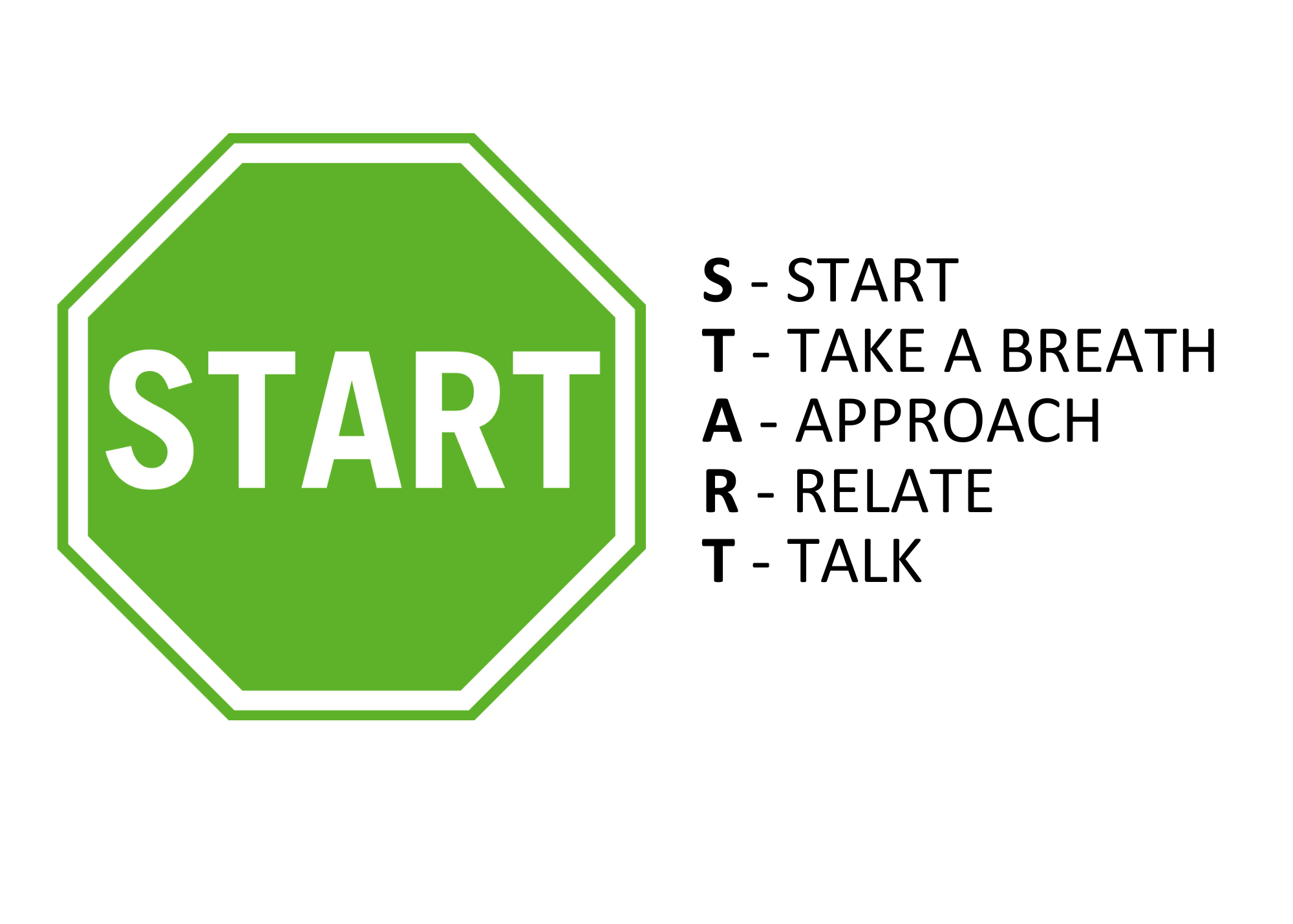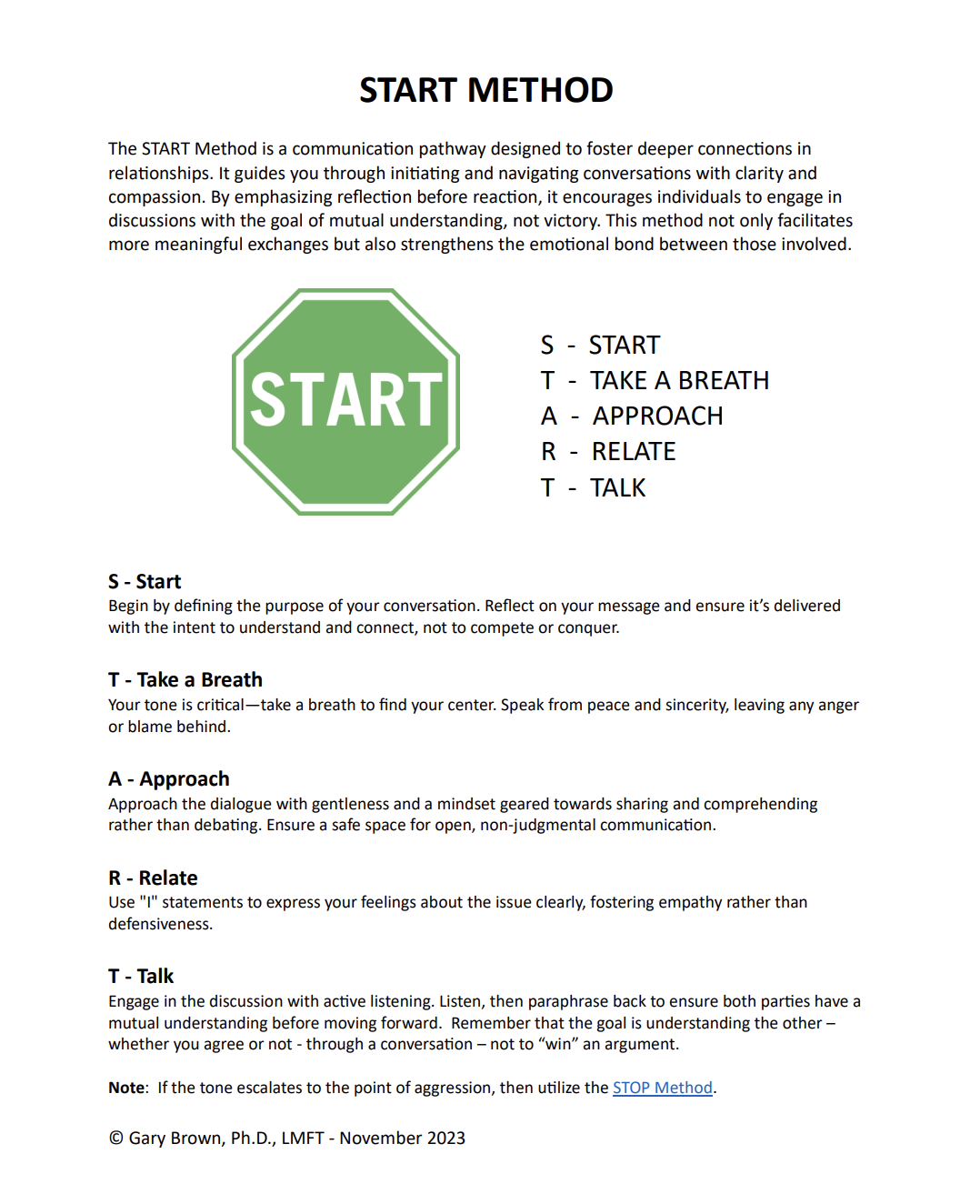The START Method: Fostering Connection and Understanding in Relationships


In interpersonal connections, especially intimate relationships, communication is not just about talking—it’s about connecting, understanding, and relating. I’ve developed the START Method to facilitate this deeper level of interaction. This five-step process is designed to help individuals approach important conversations with clarity, calmness, and the intention of achieving understanding and resolution.
Introduction to the START Method
 The START Method is a strategic approach to communication that focuses on initiating meaningful conversations from a place of composure and consideration. It’s particularly valuable in romantic or family relationships, where emotions can run high, and there’s a significant need for both partners to feel heard and understood. The method comprises five key steps: Start, Take a Breath, Approach, Relate, and Talk. Let’s delve into each step.
The START Method is a strategic approach to communication that focuses on initiating meaningful conversations from a place of composure and consideration. It’s particularly valuable in romantic or family relationships, where emotions can run high, and there’s a significant need for both partners to feel heard and understood. The method comprises five key steps: Start, Take a Breath, Approach, Relate, and Talk. Let’s delve into each step.
S – Start
Before engaging in significant dialogue, you must clarify what you want to communicate. This means taking the time to reflect on your thoughts and feelings, considering the core message you want to convey. It’s about setting intentions for the conversation ahead, ensuring that your objectives are not to win but to enhance understanding and connection.
T – Take a Breath

The tone you speak can often be as impactful as the words themselves. Before starting the conversation, take a deep breath. Ensure your voice comes from a place of calm, authenticity, and vulnerability. Do what you need to do to remove any traces of anger, blame, or aggression. This breath isn’t just a physical inhalation and exhalation; it’s a metaphorical pause to center yourself and align your intentions with your forthcoming expressions.
A – Approach
Your approach sets the stage for how the conversation will unfold. It should be gentle, non-confrontational, and with the clear intention of wanting to share and understand, not to argue or prove a point. The environment should be one of emotional safety, where both parties feel secure enough to be open and honest without fearing judgment or retaliation.
R – Relate
Relate the specific issue that you have identified at hand using “I” statements. For example, “I feel hurt when…” instead of “You hurt me by…” This method communicates your perspective without casting blame or creating defensiveness. It allows you to express how the situation affects you personally. This can help foster empathy and understanding from your partner and set the emotional stage to facilitate the rest of the conversation.
T – Talk

The final step is the actual conversation. This involves discussing the issue in a manner that allows for active listening. One partner talks while the other listens without interruption. After one has spoken, the listener repeats back what they’ve heard to confirm understanding. This reflective listening ensures both partners are on the same page and can address the heart of the matter.
How and When to Have Important Conversations
Important conversations should ideally be had when both parties are not preoccupied with other stressors. Timing is crucial. Avoid starting a serious discussion right before one has to leave for work or when one is dealing with a personal crisis.
Setting aside a specific time for the conversation can be helpful. It allows both individuals to come prepared, giving the topic prior thought.
Equally as important to the timing is the setting. These conversations have a better chance to succeed if you choose a private, comfortable setting, free from distractions that could detract both of you from the seriousness and intimacy of the dialogue.
Talking about low-level day-to-day conversations might be okay in a restaurant, but conversations that could potentially trigger intense emotions should take place in one’s home.
Applying the START Method in Relationships
In a relationship, whether you’re discussing future plans, addressing concerns, or sharing deep feelings, the START Method can be an invaluable tool. It fosters a space where both partners feel valued and understood.

For instance, if one partner wants to talk about taking the next step in their relationship, they would:
Start: Reflect on your feelings about the relationship and what moving forward means.
Take a Breath: Approach the conversation with a clear, calm mind and open heart.
Approach: Choose a comfortable, quiet setting and express the desire to have a meaningful discussion.
Relate: Use “I” statements to convey your thoughts, emotions, and desires regarding the next step.
Talk: Have an open dialogue, listen actively, and ensure both of you feel understood.
The STOP Method: Recognizing and Managing Emotional Escalation
In conjunction with the START Method for initiating meaningful conversations, the STOP Method serves as a critical companion process, guiding individuals on when to pause and recalibrate during escalating situations. It’s the emergency brake you can use to prevent a conversational collision.
Communication in relationships isn’t solely about sharing and connecting; it’s equally about recognizing when to halt negative patterns that can lead to conflict. The STOP Method is a mindfulness-based technique that acts as a preventative measure against the kind of emotional harm that can occur when discussions turn into arguments and arguments slip into fights.
When to Use the STOP Method
The STOP Method should be employed when you notice a conversation is starting to veer off course.
This could be when:
- The tone of the conversation shifts towards anger or frustration.
- You or your partner begin to feel defensive or attacked.
- The dialogue is no longer productive; you’re circling around blame rather than solutions.
- Physical signs of stress are evident, such as a raised voice, a quickened heartbeat, or a tense posture.

How the STOP Method Complements the START Method
While the START Method is about creating a positive framework for discussions, the STOP Method is about recognizing and managing when those discussions take a turn for the worse. It’s about knowing when to take a step back to prevent causing irreparable damage to the relationship.
Imagine using the START Method to discuss a sensitive topic with your partner. You’ve started with clarity, taken a breath to ensure you’re calm, approached the subject with the intent to understand, related your feelings using “I” statements, and are now talking it out. Suddenly, you hit a snag—the conversation heats up, and emotions are high.
Here’s where the STOP Method becomes essential. Instead of plowing through and risking a blowout, you call a STOP, bringing mindfulness and reflection into the moment to de-escalate the situation.
Integration of Both Methods for Relationship Harmony
Using both the START and the STOP Methods in tandem can create a robust framework for healthy communication. They encourage you to engage in discussions thoughtfully and to pause reflectively, ensuring that both partners feel respected, heard, and valued.
By mastering the timing and application of both methods, couples can navigate the complexities of their relationship with greater ease and less conflict. It’s about striking a balance between expression and reflection, speaking and listening, engaging and pausing.
Conclusion
The START Method is more than a communication tactic; it’s a philosophy of conversational engagement grounded in respect, empathy, and love. By applying these steps, couples can navigate even the most sensitive topics with grace and compassion, deepening their connection and understanding of each other.
Using the START Method consistently can transform how partners interact, leading to a more harmonious and fulfilling relationship. It’s a commitment to nurturing the bond you share and ensuring that every conversation, no matter how challenging, is approached to strengthen your connection.

To seamlessly integrate the START and STOP Methods into your conversations, consider utilizing the handouts I’ve crafted for each approach (find the STOP Method handout here). These handouts serve as practical companions, offering supportive cues and reminders that can guide you step by step. They are designed to be kept at hand, ensuring your dialogues unfold constructively and in harmony with the principles of empathetic communication.
Both clients, family, and friends who now use this method report that their conversations are more fruitful using this method.
The START Method handout below is available for those ready to enhance their conversational skills. Let it be your ally in fostering meaningful and profound connections in your relationships. I highly recommend downloading and printing several copies in color, for you to use in all of your relationships.

>> Click here to download pdf <<
Directions for Using the START Method Handout:
- Prepare: Before your conversation, review the handout to familiarize yourself with each step of the START Method.
- Keep It Accessible: During the discussion, keep the handout within sight for easy reference to ensure you follow each step.
- Step-by-Step: Progress through the conversation by applying each START aspect—begin with ‘Start,’ then ‘Take a Breath,’ ‘Approach,’ ‘Relate,’ and finally, ‘Talk.’
- Reflect: After the conversation, revisit the handout to reflect on how well you adhered to the method and identify areas for improvement.
- Practice: Regularly practicing with the handout will help embed these steps into your communication style, making the process more natural over time.
Remember, the handout is a guide to support and enhance your communication, not a script. Use it to build healthier and more understanding interactions.
Enhancing your communication skills and navigating the complexities of your relationship can be a transformative experience. Take the first step and reach out for a complimentary 15-minute phone consultation. This no-obligation conversation will help us determine if my approach fits you or your relationship. A little coaching on methods like the START can significantly impact the health and longevity of your partnership.














